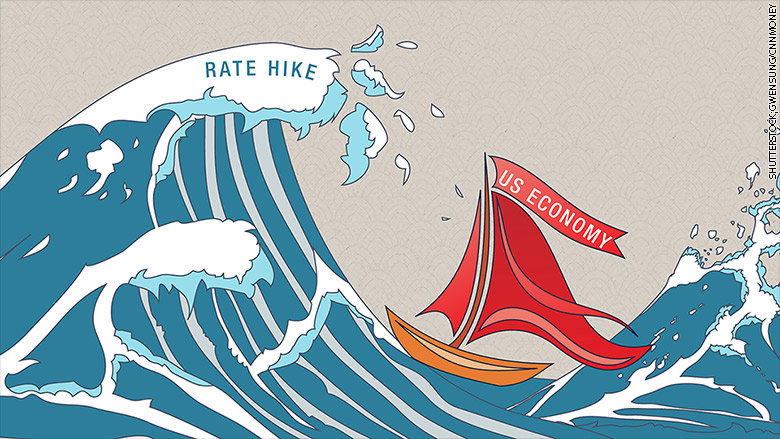
The days of smooth sailing are likely over for investors as the economy heads into uncharted waters.
The Federal Reserve is widely expected to raise interest rate later this year, perhaps as early as June. The Fed tried to jumpstart the economy during the Great Recession by cutting rates down near zero in December 2008. It hasn't touched rates since.
The stimulus fueled a stock market surge. The S&P 500 has risen about 200% since bottoming out in March 2009. A rising tide lifted all boats. But that rising tide -- the Fed's stimulus -- will soon fade.
Related: Stocks plunge, but bonds are still red hot
Everyone knows what's coming, but experts disagree on whether stocks or bonds will get hit the worst.
History isn't very helpful in giving clues about what will happen.
"We don't have a ton of experience because over 25 years the Fed has only really tightened policy three separate times," Dan Greenhaus, chief global strategist at BTIG Research, said of rate hikes. "Who wins, who loses, you sort of have a firm idea but it could change from one end to the next."
Since 1990, the Fed raised rates starting in 1994, 1999 and 2004. But those years marked the beginning of long periods of rate increases. Most experts see this rate rise by the Fed as a one-and-done deal for 2015. Call it a tip toe rate increase, not a sprint.
In short, there's no close comparison to these times, especially anything equivalent to coming out of the Great Recession.
Related: Doom and gloom dominates Corporate America
The Fed is cautious. American markets are already off to a rocky ride this year. The Dow and S&P 500 both dropped 3% in January while bonds rallied, driven by foreign investors who want a safe bet.
Events abroad are pressuring the U.S. economy and American businesses. China's economy is slowing down. Europe just announced the start of its stimulus program. The new Greek Prime Minister, Alexis Tsipras, is already causing tension with his peers on the continent. Oil prices are still very low. The strong U.S. dollar is making American exports less attractive to foreign buyers.
On top of all those factors, the build-up of anticipation to the rate rise could cause even more market volatility. If the Fed doesn't properly communicate the timing and amount of a rate hike, that could cause havoc, which is why the Fed has been signaling very loudly about its intentions to do a small increase this year.
Related: US economy misses its mark at end of 2014
The good news: stocks should calm down after the rate hike, says Tim Hopper, senior economist at TIAA-CREF Asset Management, which handles $611 billion in assets. It's akin to an athlete getting nervous before a big game, and then losing the butterflies once the game starts.
Although Hopper only sees one rate increase in 2015, he says a rate cycle, where the Fed steadily raises rates every few months, could begin in 2016.
"Leading up to that first hike this year, I would expect to see increased volatility," says Hopper. "Post-raise you would see volatility relatively slower."
Despite volatility in stock markets leading up to an interest rate increase, stocks should regain their steam and begin to outperform bonds in the middle of a rate cycle, Hopper says.
Related: OPEC leader: Oil could shoot back to $200
"Stocks tend to get more comfortable because when the Fed is raising rates," Hopper says, explaining that the rate hike is a signal that the economy is getting stronger. "As you go into the third or fourth rate increase...stocks begin to outperform."
Big impact: Winners and losers during a rate hike are hard to predict given the lack of historical precedent.
Bonds tend to perform poorly around the time of a rate hike, says Greenhaus. Bonds are already very pricey and the Fed rate increase could burst that bubble.
But this rate hike could be different for bonds. Demand for U.S. treasuries is near its highest point in 30 years, which was not a factor during past rate hikes.
Related: Here are the drivers of future economic growth
Over very long time periods, bonds generally outperform stocks when the Federal Reserve raises its key interest rate, the Federal Funds Rate, and the discount rate, according to Bob Johnson, CEO of the American College of Financial Services. He co-authored a book, "Invest with the Fed," that debuts in March.
When interest rates fall, stocks outperform bonds on average, and small stocks do particularly well, Johnson says. While his research would generally point toward bonds now, he notes that sometimes these trends don't hold.
Perhaps the only thing experts agree on fully is that the Fed rate hike this year could be the biggest factor impacting stock and bond prices.
"From a [big picture] macro standpoint, I don't believe there's any influence that's greater than Fed policy," says Johnson. "There is a very strong association between Fed monetary policy and capital market returns."


